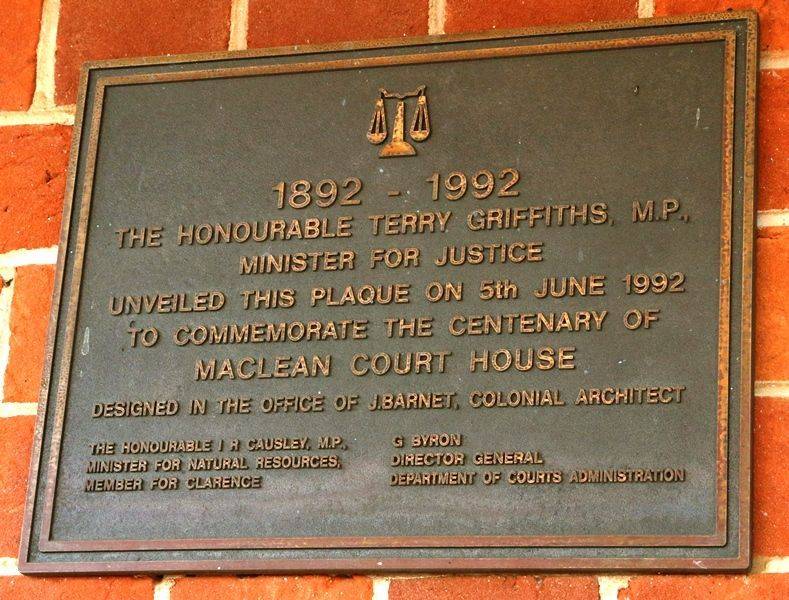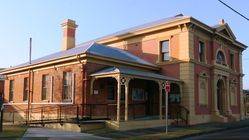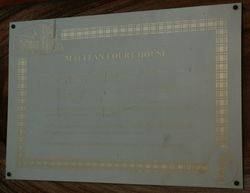
Home » Themes » Government » Colonial
Centenary of Maclean Court HousePrint Page 
The plaque commemorates the centenary of the Maclean Court House.
Completed in 1893, this is one of the last Court Houses designed by the colonial architect James Barnett. The Court House is situated on the same site as the previous building, which was demolished in 1890. Work on the new court house commenced in 1891. The contract was awarded to Mr C.B. Smith and the total cost of construction was £2,581. Interestingly, no opening ceremony was ever performed. The first session was held on March 1st, 1892 in spite of the fact that the new furniture had not yet arrived! This building is a magnificent example of Victorian architecture, boasting a lavish use of cedar wood, vaulted ceiling and teak flooring.
Court-house.-The new Court-house, recently completed, may be classed as one of the most substantial buildings in Maclean, and it is to be regretted that it does not occupy a more prominent position. lt is erected on the site of the old Court- house and is only seen to advantage from one point. The building is of brick on a concrete foundation, and is finished in a manner creditable to the contractor (Mr. C. B. Smith), and satisfactory to the clerk of works (Mr. J. Bushby). The edifice fronts the river and has an imposing appearance. In the centre is the court-room, 45 x 31 foot, and high in proportion, it is splendidly finished off, especially the ceiling, the cove of which, a very fine quality of a nicely designed corrugated iron suitably painted, is very noticeable. The fittings and joinery work are of cedar. The usual provision for reporters was omitted, but in response to applications, the Member notifies that instructions have been given to have this attended to. The walls are kalso-mined in two shades. The accoustic properties, as far as have been tested, prove satisfactory. On either side of the court-room is a spacious hall; off this on the right are the C.P.S'. office and jury rooms, and on the left the judges and magistrates' rooms. The building is plastered on the inside, Keen's cement being used solely for the dados, which presents the appearance of marble, and is an improvement on the ordinary plaster.
The exterior facings of the building are also cemented. The floors throughout are of teak. The yard is enclosed by a galvanised iron wall, and the level of the ground has been raised considerably. The sanitary arrangements have received attention, a six-inch piped drain leads to the river, and is provided with a clap-trap on the principle of a flood gate, which, in addition to preventing the influx of flood water prevents unpleasant gases from being emitted from the pipe, which would be caused if a current of air were allowed to pass through it. This sewer will ultimately be extended to the new post and telegraph premises, adjacent. The necessary furniture for the new premises has not yet been provided.
Clarence and Richmond Examiner (Grafton, NSW ),
27 February 1892.
Location
| Address: | Macnaughton Place, Maclean, 2463 |
|---|---|
| State: | NSW |
| Area: | AUS |
| GPS Coordinates: | Lat: -29.458204 Long: 153.196025 Note: GPS Coordinates are approximate. |
Details
| Monument Type: | Plaque |
|---|---|
| Monument Theme: | Government |
| Sub-Theme: | Colonial |
| Approx. Event Start Date: | 1892 |
| Approx. Event End Date: | 1992 |
Dedication
| Actual Monument Dedication Date: | Friday 5th June, 1992 |
|---|
1892 - 1992
The Honourable Terry Griffiths, M.P. Minister for Justice unveiled this plaque on 5th June 1992
To commemorate the centenary of Maclean Court House
Designed in the office of J. Barnett, Colonial Architect
The Honourable I H Causley, M.P. Minister for Natural Resource, Member for Clarence
G Byron Director General Department of Courts Administration







